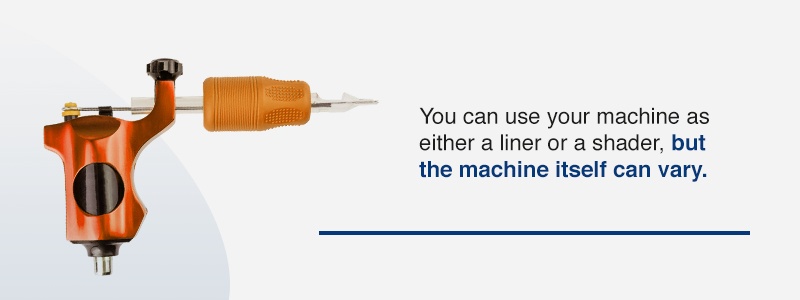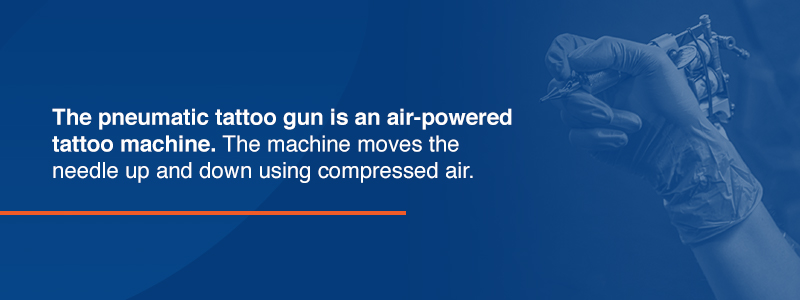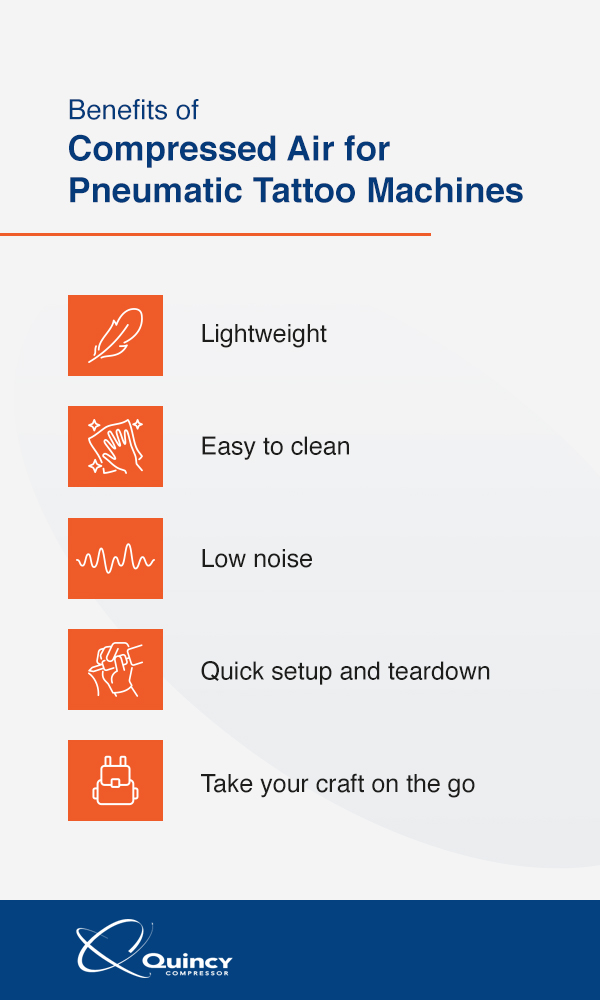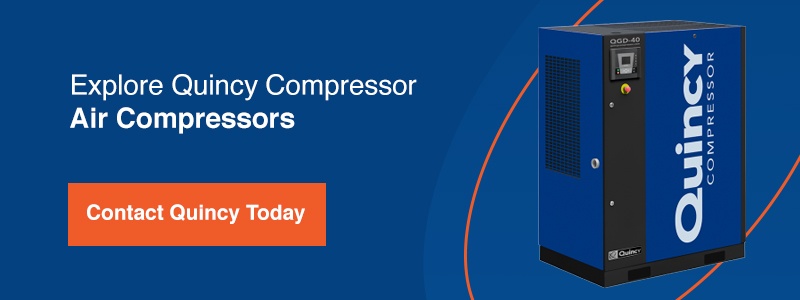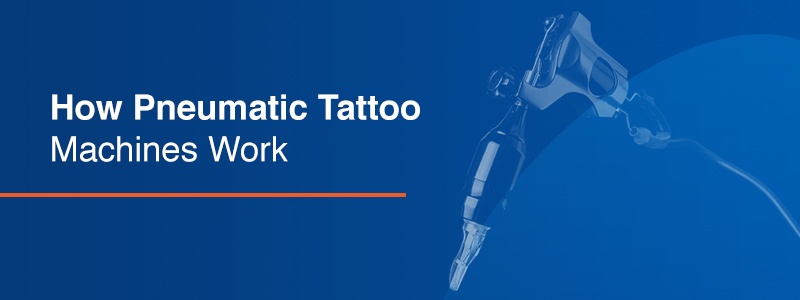
Artists understand that their tools influence their work. A tattoo artist with a low-quality tattoo machine will likely feel a sense of limitation. Each of your clients wants a different type of tattoo, and the possibilities are endless. Are you ready to tackle any client request that comes your way? Having an optimal tattoo machine is crucial to the success of your work. But not all tattoo machines are the same. Over the last few decades, a new product has emerged — the pneumatic tattoo machine. This machine has the potential to change how you approach your craft.
What Are Tattoo Guns?
Tattoo machines, also referred to as tattoo guns, are the centerpiece of the tattoo industry. Without them, tattoos might be far less common, and they would take far longer to produce. The industry today includes many clients who want large, intricate tattoos. These often take several multi-hour sessions to complete. The advent of tattoo guns has made the process easier and more precise.
When you give someone a tattoo, you’re injecting ink into their dermis with a tattoo gun. The dermis is the layer of skin beneath the epidermis, which is the visible top layer of skin. The tattoo gun is a powered machine that rapidly moves a needle up and down to penetrate the dermis, depositing ink. With careful attention and a steady aim, you use the tattoo gun to create a beautiful work of art on your client’s body.
Every tattoo gun possesses these three components:
- The needle
- The armature bar
- The tube
The needle connects to the armature bar, which is what moves it up and down. The armature bar receives its motion from a power source, which differs among the types of tattoo guns. The needle is housed within a tube that is just long enough to let the tip of the needle stick out with each downward movement of the armature bar. This process of constant movement brings ink to the needle, and the needle delivers that ink into the client’s dermis.
The goal of every tattoo gun is to deliver ink into the client’s skin. The armature bar’s power source is where tattoo guns differentiate themselves.
Different Types of Tattoo Guns
Tattoo guns vary in their appearance and construction. There are many brands on the market, and you can choose the one that fits your style and experience level. As a tattoo artist, you know there are two basic techniques for creating tattoos, and each requires a different needle or machine. These practices are shading and lining, and their respective machines are known as shaders and liners.
Shaders, also called long-stroke tattoo machines, are used to shade an area of skin. This is necessary when adding color or giving an area of skin gradient shading. Shaders use more needles than liners and move in a slower, more methodical manner. The purpose is to completely color an area of skin, leaving no part untouched. Since shaders are slower and cover more area, they are also gentler on the skin, which is important when dealing with a large area that needs color.
Liners specialize in giving clients straight, intentional lines. This is necessary for detail-oriented work. Once you start giving a client a line, you must continue till the end or risk interrupting the line when you restart. Liners use fewer needles than shaders, but they pierce the skin at a much quicker rate. This causes liners to be more painful for clients, but it is necessary to achieve perfect lines completed in a single movement. Liners are also known as short-stroke tattoo machines.
You can use your machine as either a liner or a shader, but the machine itself can vary. There are three different types of tattoo machines available, and each carries out the same function in a different way:
1. Rotary Tattoo Gun
The rotary tattoo gun is the most popular of the tattoo machines. This is due to a few reasons, the first of which is noise. When performing an extensive tattoo session for a client, neither of you will enjoy hearing a drawn-out, annoying noise for hours. The rotary tattoo machine is relatively silent, saving you and your clients from any obnoxious sounds.
A rotary gun uses an electric motor to power its armature bar. This moves the needle up and down in rapid, cyclical motions. You can trust that the rate of your needle’s movement will be consistent, letting you carry out your work with confidence. Thanks to the fact that a rotary tattoo gun uses few components, including a lightweight motor, it weighs very little. It won’t tire out your hand, which can help you get through even the longest tattoo sessions.
Rotary tattoo guns are a good choice if your client is worried about skin damage. With their smooth, even movements, rotary guns allow you to go lighter on your client’s skin. While you can use them for either lining or shading, their gentler, faster movements make them better to use in the shading process. It’s more difficult to make straight lines with rotary tattoo guns. Some rotary guns also have options that let you switch needles with minor adjustments during sessions, giving you greater customization while creating tattoos.
If you’re going to be doing mostly shading and you want to give yourself and your clients a quieter experience, a rotary tattoo gun may be a great choice for you.
2. Coil Tattoo Gun
Coil tattoo guns get their name from the process that moves their armature bar. An alternating electromagnetic current passes through coils at the top of the machine, engaging and disengaging a magnet. This forces the armature bar up and down, tapping like a tiny hammer on the top of the needle, to continuously drive the needle into the client’s skin. This process causes coil tattoo guns to be pretty loud. It creates the signature whirring or buzzing sound many people associate with tattoo parlors.
The rate at which the needle moves in coil tattoo guns is slower than in rotary tattoo guns. You can use coil tattoo machines for both shading or lining, but their firm, intentional needle movements make them a solid choice for shading and blending in lines. They’re great at performing intricate work thanks to their slower strokes. They also use a bit more force than rotary tattoo guns, causing more damage to the client’s skin.
Coil tattoo guns may not be the best choice for a beginning tattoo artist. They contain many intricate components, making them both heavier and more complex than rotary tattoo guns. Their loud sound can also be off-putting during long sessions. While they offer customization opportunities and the ability to perform advanced, intricate work, many new tattoo artists gravitate toward rotary tattoo guns. Artists looking to challenge themselves might consider a coil tattoo gun.
3. Pneumatic Tattoo Gun
The pneumatic tattoo gun is an air-powered tattoo machine. The machine moves the needle up and down using compressed air. When it was introduced in the early 2000s, no one had seen anything like it. With its higher price, tattoo artists seemed skeptical about switching from the more familiar coil and rotary tattoo machines. Although it is a less common tattoo gun, its benefits might make it the best choice available for you.
A pneumatic tattoo gun is the most silent of the three types of tattoo machines. Using compressed air as its source of power means there is no need for humming, electric motors or noisy, buzzing coils. You can adjust the air pressure to change the speed of the needle. It’s lightweight, which makes it practical for long inking sessions. And since it uses most of the same connections and needles used for coil and rotary tattoo machines, you’ll have an easy time finding parts and accessories for it.
Tattoo artists must consider the sanitation of their equipment. Whether you use disposable tubes or washable stainless steel ones, you need to make sure you’re giving your clients a clean and fully sanitized experience. That includes cleaning your tattoo machines. Since pneumatic tattoo guns are air-powered instead of using sensitive internal components, they can be easily cleaned in an autoclave. This can cut down on the time and effort you’d normally spend cleaning your gear, letting you focus more on your latest designs and tattoo sketches.
Thanks to their lighter weight and compatibility with most accessories and needles, pneumatic tattoo guns are a great choice for both lining and shading. They allow you to keep up your stamina during long tattoo sessions and have full control over your project, even for the most intricate designs.
Evolution of Tattoo Guns
People have given and received tattoos throughout human history. In cultures around the world, tattoos have always been signs of dedication, love, creativity and even societal status. The earliest known use of tattoos dates back 5,200 years ago. These earliest instances of tattooing used primitive technology, but were tattoos nonetheless.
Tattooing has always involved the same thing — finding a way to get ink into someone’s dermis to make permanent designs. Tattoo artists accomplish this in the following three ways:
- Piercing
- Puncturing
- Cutting
Different cultures have used varying methods for the tattooing process, some being signs of religious or spiritual devotion. Early tattooing tools included comb-like devices that artists dipped into ink and pierced into the skin. Some people would pierce the skin in a design until they drew blood. They would then smear ink into these wounds so that when they healed, it would trap the ink under the skin in the desired design.
As generations passed, artists developed other methods, such as using long needles made of bone or glass to repeatedly pierce the skin with ink. Artists would sometimes place these needles in long tubes to give themselves more control over the designs.
In 1876, Thomas Edison invented the inspiration for modern tattoo machines. He created an electric motorized pen that would pierce holes into materials to create stencils that could be used to mass-produce text. While the invention didn’t maintain much popularity in the publishing world, tattoo artists saw its potential. Before the turn of the century, the rotary tattoo machine had been patented. In the early 1900s, the coil tattoo gun followed suit. They were the only two tattoo machine options throughout the 1900s.
With the new millennium came a new tattoo machine: pneumatic tattoo guns. They broke new ground, as no one had ever seen someone use an air compressor tattoo machine before. Now, with all their benefits, pneumatic tattoo machines could change how tattoo artists approach their craft for years to come.
Benefits of Compressed Air for Pneumatic Tattoo Machines
Never before has such a versatile, lightweight and user-friendly option as the pneumatic tattoo gun been available for tattoo artists. Using an air compressor for your tattoo machine may feel foreign at first, but before long you may never want to go back to your old rotary or coil machine. Using compressed air as the power source for your tattoo machine has some undeniable benefits, including the following:
- Lightweight: The lack of motors or coils means that your pneumatic tattoo machine is easy to hold and operate. This can help you succeed in even the longest tattoo sessions.
- Easy to clean: Cleanup is easier since you can sterilize a pneumatic tattoo machine in an autoclave. Washing the components by hand can be a thing of the past.
- Low noise: Enjoy more peace and quiet as you work with no buzzing sounds from motors or coils.
- Quick setup and teardown: Pneumatic tattoo machines are compatible with standard tattoo accessories. Since all you have to do is hook up to an air compressor, getting started and tearing down after a long day’s work is simple and convenient.
- Take your craft on the go: With a pneumatic tattoo machine, as long as you have a place to power your compressor, you can give clients tattoos anywhere. From festivals to outdoor art venues, you’re only limited by where you want to create.
Explore Quincy Compressor Air Compressors
Quincy Compressor specializes in creating quality air compressors that are reliable power sources for any job application. As a tattoo artist, you understand the value of quality equipment that helps bring your clients’ visions to life. We can help you achieve that with a power source you can be confident in.
If you’re interested in pneumatic air compressors, contact us today for more information on how we can help. Experience the efficiency of air compressors, and take your craft to the next level.


